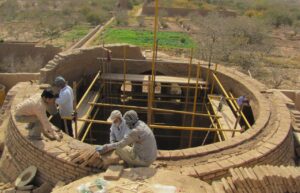‘Why Not Reconstruction’ Theoretical and Practical Considerations: The case of Dih Nu Jami Mosque, Iran
The Jami Mosque of Dih Nu is the only surviving architecture heritage of a 14th-century abandoned neighborhood, which is believed, was demolished by flooding. The site has gradually turned into the agricultural lands and farms, therefore, was subjected to gradual physical damages and no single roof was present in the whole building. Since there was no alterations and repair works, the original plan and structure remained highly authentic. Although a roofless and partly ruined structure, there was a strong commitment among the local people to maintain the mosque; so they keep having the building cleaned and say their prayers there. Full documentation and research reflected in a conservation plan and step-by-step implementation and recording of all the conservation works. This is a conservation plan which matches perfectly with the cultural context, and the community were ready to invest and contribute voluntarily. The strategy was to learn from the original building, applying techniques coherent to the past structure, taking the high quality local workmanship as the foundation, combining with additional structural treatments to consolidate and reconstruct its original form and fabric. The project is a good example of a homogeneous conservation technique, a systematic approach, and a long-term implementation strategy on an earthen heritage in Iran.
Eisa Esfanjary is currently an Assistant Professor of Architectural and Urban Conservation at the Art University of Isfahan, contributing significantly in undergraduate, postgraduate and PhD programs. He is an experienced and hands on Conservation Architect who restored over 30 Historic buildings and sites in Iran. His publication is extensive and his most recent book entitled ‘Persian Historic Urban Landscapes: Interpreting and Managing Maibud over 6000 Years’ was published by Edinburgh University Press in October 2017, which was highly acknowledged by International experts in the field. He is currently a Principal Investigator (PI) of a large research project entitled ‘Conservation Master Plan for the Historic Cities in Iran, funded by The Research Institute of Iranian Cultural Heritage and Tourism Organization.


